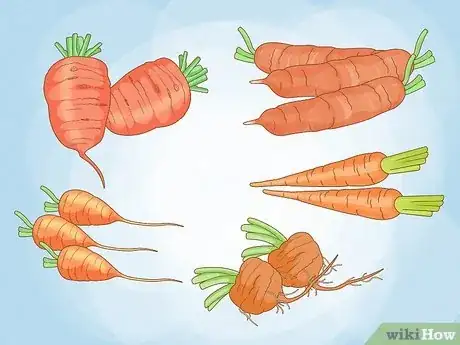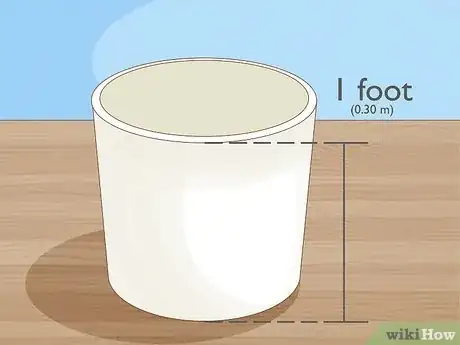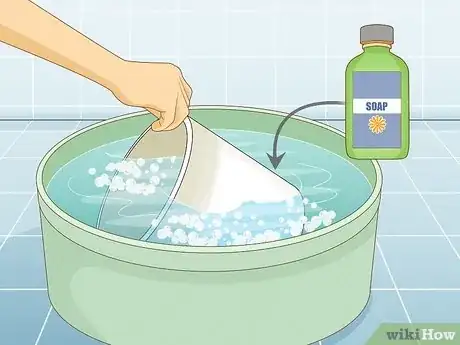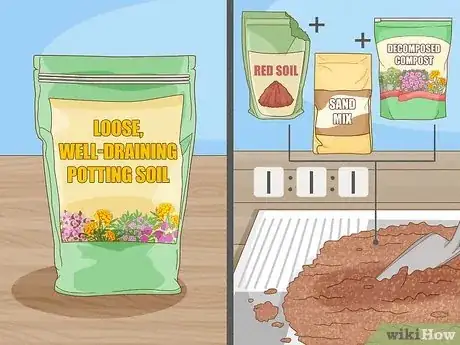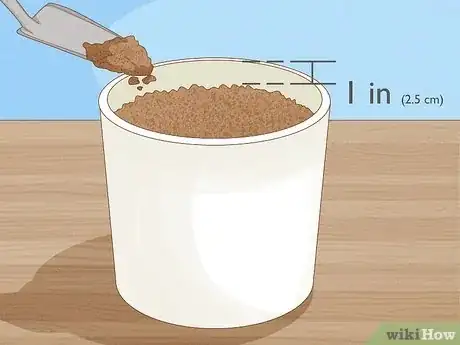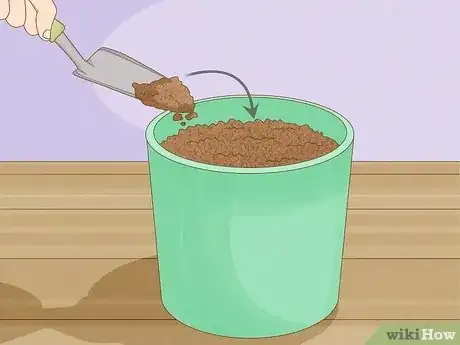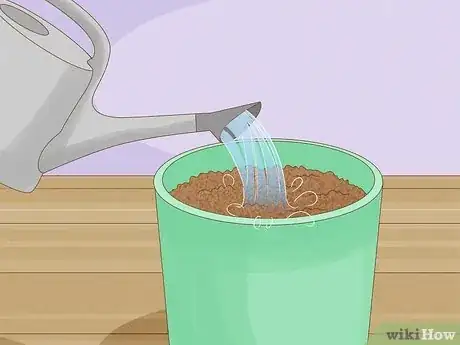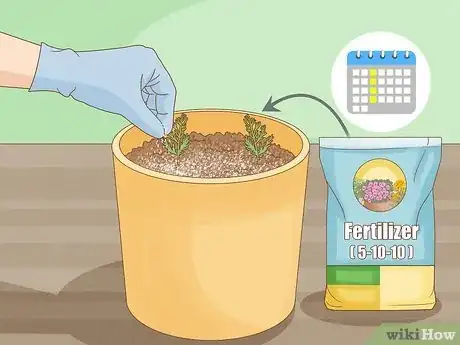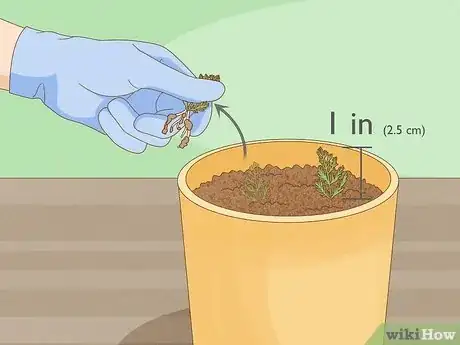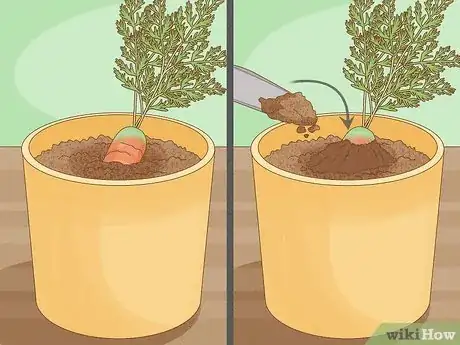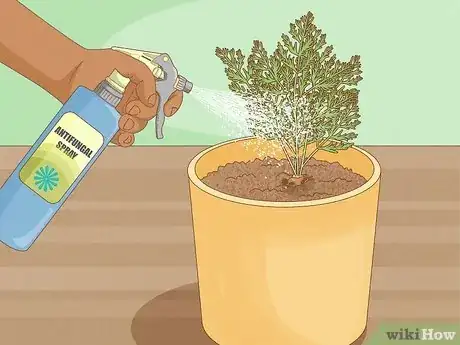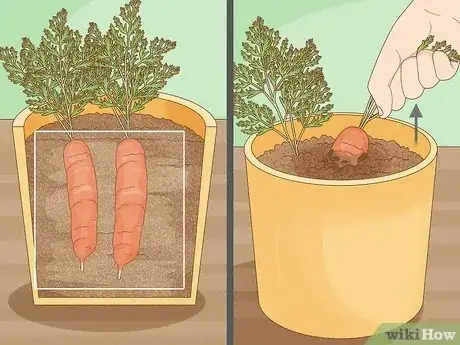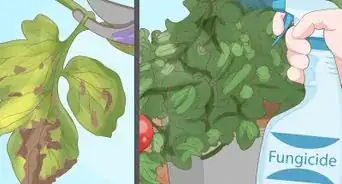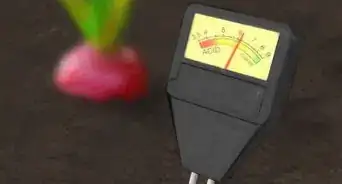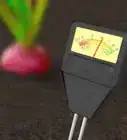This article was co-authored by Maggie Moran. Maggie Moran is a Professional Gardener in Pennsylvania.
There are 11 references cited in this article, which can be found at the bottom of the page.
wikiHow marks an article as reader-approved once it receives enough positive feedback. In this case, several readers have written to tell us that this article was helpful to them, earning it our reader-approved status.
This article has been viewed 338,714 times.
If you have limited garden space, you can grow carrots in pots instead. While many standard-length carrots don't grow as long in containers, most smaller varieties thrive in them. Make sure you have a deep container that allows the edible root to grow well into the soil, and keep the soil wet to maximize growth.
Steps
Getting the Pot Ready
-
1Select a shorter carrot variety. Smaller varieties typically adapt to container growing better than standard-length varieties. It's also a good idea to choose varieties that have a shorter maturing time.
- Smaller varieties include Thumbelina, Romeo, Oxheart, Little Finger, Short 'n' Sweet, or Parisienne.[1]
- You can also try Parmex, Danvers Half Long, Chantenay Red Core, and Shin Kuroda.
-
2Choose a wide container that's at least 1-foot (0.30-m) deep. Deeper is even better. Carrots develop underground, and the root system needs a lot of space to grow. Similarly, the wider the pot is, the more carrots you can grow.[2]
- The container should also have adequate drainage holes to prevent excess water from causing the carrots to rot.
- The type of container does not matter much as long as it has enough depth. Clay, plastic, or stone is fine, whether circular or rectangular.
- If your pot doesn't have drainage holes, you can drill your own.
Advertisement -
3Clean your container with soap and water. If you have a previously used container, scrub out the inside before planting your carrots. Bacteria and microscopic insect eggs often hide inside used containers and may hinder your yield if they infect your carrot plants.[3]
-
4Pick a loose, well-draining potting media. Both soil and soilless mixtures can work. If you want to buy your soil, pick one meant for container vegetables. If you do buy your own soil, try adding in peat moss. It can make up 30%-50% of your soil.[4] Alternatively, you can add horticultural sand to the mix, and it can make up 30% of your soil.
- Try a mixture of red soil, decomposed compost, and sand mixed in equal portions for a soil-based media you make yourself.
- Consider coco peat mixed with a small amount of perlite for a soil-less media.
- Find all of these components at your local garden store. Ask a sales associate for a recommendation, if necessary.
-
5Fill your container with the soil or soilless medium. Leave1 inch (2.5 cm) of empty space between the top of the media and the rim of the container. You can also mix a slow-releasing fertilizer into the soil, but pick one that has less nitrogen, such as a 5-10-10 mix. Nitrogen will encourage leaf growth instead of carrot growth.[5]
Planting Your Seeds
-
1Plant after the first frost if you're planting outdoors. Carrots like cooler weather, but they still won't take kindly to frost. Their preferred temperature is around 55 °F (13 °C) or a bit warmer, so early spring is fine.
- However, they don't do well in temperatures over about 85 °F (29 °C).
-
2Dig holes that are 1/2 an inch (1.25 cm) deep. Space your carrots about 1⁄2 to 1 inch (1.3 to 2.5 cm) apart. You can plant them further apart if you wish. Drop 2-3 carrot seeds in each hole.[6]
- Carrot seeds are tiny and hard to plant. If you drop some, that's fine. You can thin out the plants later once they sprout.
-
3Fill the holes in with your planting medium. Do not pack the medium into the holes since doing so may crush the seeds. Instead, lightly drop the medium into each hole. Make sure you get every hole filled.[7]
- Pat the soil down gently when you're done.
-
4Water the seeds thoroughly. Add enough water to make the medium very wet. You don't need to make puddles, but your soil should be wet to the touch, not just moist. Your seeds need enough water to start the germination process.[8]
- Use a gentle sprayer so you don't stir up the seeds.
-
5Place your pot in full sun. Most carrots prefer full sun, meaning they want sun all day long. Choose a spot in your yard or home that isn't shaded during the day, where your carrots will get enough light to be happy and grow well.[9]
- Always read up on your variety, as some carrots prefer other conditions. For instance, some may prefer partial sun and partial shade.
Caring for and Harvesting Carrots
-
1Water your carrots daily in warm weather. You may even need to water them twice a day during hot, sunny weather. Do not let the soil stay dry for any extended amount of time.[10]
- Stick your finger in the soil to see if it's moist. If it's not, you need to water it.
- In most cases, tap water works well for carrots. However, if the water you use for your garden is treated with a water softener, use distilled water for your carrots, instead.
-
2Feed your carrots with fertilizer once a week or so to encourage growth. Try a 5-10-10 fertilizer, which has less nitrogen. That will encourage the roots to grow instead of the leaves. However, it's not absolutely necessary to use fertilizer with carrots.[11]
-
3Thin out your carrots once they reach 1 inch (2.5 cm). Once your carrots start to grow into seedlings, cut out any extra plants with scissors or gardening shears. The plants you keep should be spaced 2 to 3 inches (5.1 to 7.6 cm) apart to help them grow.[12]
- If you try to pull out the unwanted seedlings, you could damage your other plants.
-
4Use additional growing medium to correct growth problems. If your carrots start leaning, straighten them up gently and add soil to stabilize them. Similarly, if your carrots start peeking through the top of the soil, cover them up with more soil.[13]
- When carrots peek out of the soil, they turn green at the top. It doesn't harm them, but they don't look as pretty.
-
5Spray your carrots with an antifungal spray if you notice white mildew. Container carrots won't be as susceptible to pests and disease, but you may still get a fungal infection from time to time. You'll notice a white, powdery substance on the leaves. You can buy antifungal sprays or make your own.
- Make an anti-mildew spray by adding a tablespoon (14 grams) of baking soda to 1 gallon (3.8 L) of water with a squirt of dishwashing liquid. Mix it up, and apply it to the plant with a spray bottle once a week.[14]
-
6Harvest your carrots when they reach peak color. Depending on the variety, your carrots could be yellow, red, orange, or purple. Generally, they will take 2 to 2 1/2 months to fully mature and reach the right color. Grasp the greens near the top of the root and gently wiggle them out of place.[15]
- The earlier you harvest mature carrots, the sweeter they will be when you can finally eat them.
Expert Q&A
Did you know you can get expert answers for this article?
Unlock expert answers by supporting wikiHow
-
QuestionHow deep does a planter box need to be for carrots?
 Maggie MoranMaggie Moran is a Professional Gardener in Pennsylvania.
Maggie MoranMaggie Moran is a Professional Gardener in Pennsylvania.
Home & Garden Specialist
-
QuestionHow can you regrow carrots?
 Maggie MoranMaggie Moran is a Professional Gardener in Pennsylvania.
Maggie MoranMaggie Moran is a Professional Gardener in Pennsylvania.
Home & Garden Specialist
-
QuestionWhat time of year do you plant carrots?
 Maggie MoranMaggie Moran is a Professional Gardener in Pennsylvania.
Maggie MoranMaggie Moran is a Professional Gardener in Pennsylvania.
Home & Garden Specialist
References
- ↑ https://www.hobbyfarms.com/your-step-by-step-guide-to-growing-carrots-in-containers/
- ↑ https://www.hobbyfarms.com/your-step-by-step-guide-to-growing-carrots-in-containers/
- ↑ https://www.quickcrop.co.uk/blog/grow-carrots-containers/
- ↑ https://gardenerspath.com/how-to/containers/grow-carrots-containers/
- ↑ http://balconygardenweb.com/growing-carrots-containers-grow-carrots-pots/
- ↑ https://www.hobbyfarms.com/your-step-by-step-guide-to-growing-carrots-in-containers/
- ↑ https://www.quickcrop.co.uk/blog/grow-carrots-containers/
- ↑ https://www.quickcrop.co.uk/blog/grow-carrots-containers/
- ↑ https://gardenerspath.com/how-to/containers/grow-carrots-containers/
- ↑ https://www.hobbyfarms.com/your-step-by-step-guide-to-growing-carrots-in-containers/
- ↑ http://balconygardenweb.com/growing-carrots-containers-grow-carrots-pots/
- ↑ http://balconygardenweb.com/growing-carrots-containers-grow-carrots-pots/
- ↑ https://www.quickcrop.co.uk/blog/grow-carrots-containers/
- ↑ https://www.youtube.com/watch?v=yFD97jAdtKU&feature=youtu.be&t=41
- ↑ https://gardenerspath.com/how-to/containers/grow-carrots-containers/
About This Article
To grow carrots in pots, start in the early spring by filling a wide container that’s at least 1-foot deep with a soil made specially for container vegetables. Next, plant your seeds 1 inch apart in holes that are ½ inch deep and cover the holes with soil. Then, water until the soil is wet to the touch, and leave your container in an area of your yard that gets sunlight all day long. Afterwards, continue to water your carrots once or twice a day to keep the soil moist. For more advice from our Horticultural co-author, including how to harvest your carrots, keep reading!
